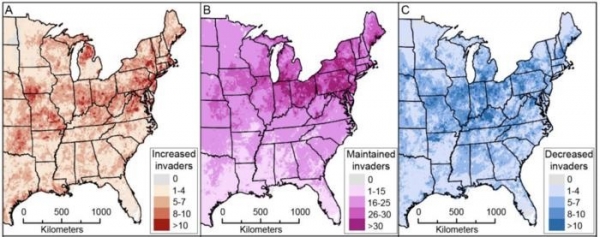Researchers at the University of Massachusetts Amherst recently published a pair of papers that, together, provide the most detailed maps to date of how 144 common invasive plants species will react to 2º C of climate change in the eastern U.S., as well as the role that garden centers currently play in seeding future invasions. Together, the papers, published in Diversity and Distributions and BioScience, and the publicly available maps, which track species at the county level, promise to give invasive species managers in the U.S. the tools they need to proactively coordinate their management efforts and adapt now for tomorrow’s warmer climate.
Mapping Future AbundanceOne of the major hurdles in addressing the threat of invasive species is in determining when and where a species crosses the line from being non-native to invasive. A single occurrence of, say, purple loosestrife, does not an invasion make. What invasive plant managers need to know is where a species is likely to take over, outcompeting native plants and altering the ecosystem.
Read More: University of Massachusetts Amherst
The number of invasive plant species across the eastern United States that (a) increase, (b) are maintained, or (c) decrease abundance habitat with +2°C climate warming. (Photo Credit: Evans et al., 2023)


